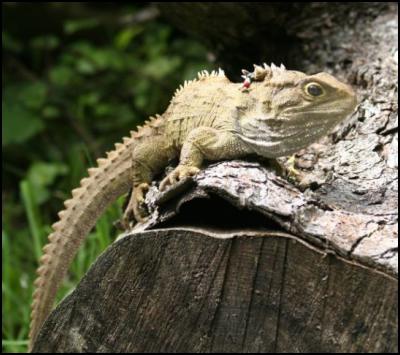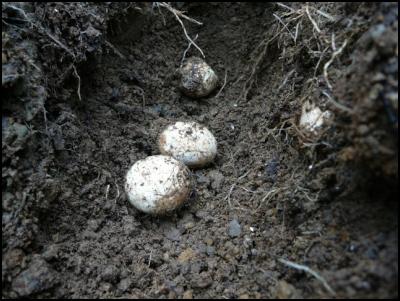‘Living fossil’ nesting on the mainland
31 October 2008
New Zealand’s
‘living fossil’ confirmed as nesting on the mainland for
the first time in 200
years!

Conservation
staff at Wellington’s world-first Karori Sanctuary have
found what is almost certainly the first confirmed tuatara
nest on mainland New Zealand in over 200 years. The
discovery came during routine maintenance work near the
Sanctuary’s unique mammal-proof fence, when staff
uncovered the four ping-pong ball sized leathery white eggs.
‘This time last year we found a gravid (egg-carrying) female’ said Sanctuary Conservation Manager Raewyn Empson.
‘We knew of two suspected nests but didn’t want to disturb them to confirm whether or not they contained eggs. The nest in this photo was uncovered by accident, and is the first concrete proof we have that our tuatara are breeding. It suggests that there may be other nests in the Sanctuary we don’t know of.’
The eggs were immediately covered up again to avoid disturbing their incubation. Although only four eggs were unearthed, it is likely that there are more in the nest – an average clutch contains around ten. The eggs would have been laid almost exactly one year ago in a shallow trench dug by the female and then backfilled.

Other than guarding the nest for a few days after laying to prevent other females digging the nest up, that is the end of maternal responsibility. All being well, the tuatara could hatch any time between now and March. The hatchlings will break out of the eggs using a special egg-tooth that will fall off after about two weeks. For the first six months or so the legendary ‘third eye’ for which the tuatara is most famous will be visible as a white patch on the forehead. This too will disappear as the tuatara grows.
As with some other reptiles, soil temperature will determine the animals’ gender. Warm soil (over 21 degrees) results in males, and cool soil (under 21 degrees) females. Background
Tuatara are the only extant members of the Order Sphenodontia and endemic to New Zealand. Every other species in this Order became extinct about 60 million years ago, leading scientists to refer to tuatara as ‘living fossils’.
It is uncertain exactly how long tuatara have been absent from mainland New Zealand but they rare if not extinct by the late 1700s due to egg predation primarily by rats (especially the kiore or Pacific rat). The re-establishment of a population at the rat-free Karori Sanctuary in 2005 was a breakthrough in re-establishing this species in the wild on mainland New Zealand. It has also made the species a lot more visible to the public.
70 animals were transferred to the Sanctuary in 2005 from Takapourewa (Stephens Island) in the Marlborough Sounds and gifted into the Sanctuary’s care by their kaitiaki (guardians) Ngati Koata. Another 130 animals were released in 2007.
The Sanctuary was recently acknowledged as one of Australasia’s top 25 ecological restoration projects by the Australia-based EMR Journal.
Additional information on tuatara breeding behaviour
o Tuatara breed only every two to four years.
o Unlike lizards, the male tuatara does not have a pe_nis. He mounts the female and passes sperm straight from his cloaca to hers (the cloaca is a small opening that serves the intestinal, urinary and genital tracts of certain reptiles and birds).
o Female tuatara become fertile at about 13 years age.
o She will carry up to 12 eggs for nine months.
o The leathery eggs will be laid between October and December; buried and abandoned.
o After about 12-15 months the eggs hatch, the young using an egg tooth to break out of their shells. From day one, tuatara take care of themselves.
o Like alligators, crocodiles and turtles, a tuatara’s gender is determined by the temperature at which it was incubated in the egg. Eggs laid in warm soil hatch into males, those in cool soil hatch into females, and those in moderate or oscillating temperatures into a mix of both.
o Tuatara are born with a legendary ‘third eye’ (actually a light-sensitive pineal gland) on the top of their skulls. This slowly closes over as they mature.
ENDS


 NIWA: Students Representing New Zealand At The ‘Olympics Of Science Fairs’ Forging Pathway For International Recognition
NIWA: Students Representing New Zealand At The ‘Olympics Of Science Fairs’ Forging Pathway For International Recognition Coalition to End Big Dairy: Activists Protest NZ National Dairy Industry Awards Again
Coalition to End Big Dairy: Activists Protest NZ National Dairy Industry Awards Again Infoblox: Dancing With Scammers - The Telegram Tango Investigation
Infoblox: Dancing With Scammers - The Telegram Tango Investigation Consumer NZ: This Mother’s Day, Give The Gift Of Scam Protection And Digital Confidence
Consumer NZ: This Mother’s Day, Give The Gift Of Scam Protection And Digital Confidence NZ Airports Association: Airlines And Airports Back Visa Simplification
NZ Airports Association: Airlines And Airports Back Visa Simplification Netsafe: Statement From Netsafe About Proposed Social Media Ban
Netsafe: Statement From Netsafe About Proposed Social Media Ban